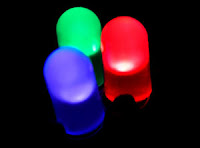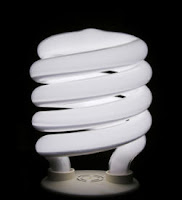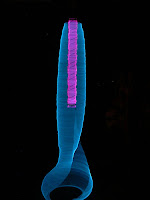LEDs and Other Technologies for Producing Light
 Whenever I come across a technology that is not well summarized on the web I feel an urge to take all the information accessible and blog on it - so everyone else does not have to fight as hard to find all the links, and get all the necessary information... like I did. Lighting, by whatever method, is one of the handful of areas that we involved with appropriate technology need to be familiar with - in addition to quality shelter, decent sanitation, clean water, efficient cooking, secure production of food from their agricultural efforts, and good health. This week I became particularly interested in lighting again (I pushed compact fluorescent bulbs since the early '80s, when they were expensive and regularly problematic - now they are cheap and mainstream) after I recently did a workshop on photovoltaics (see the post below) for emerging economies - high grade electrical energy is hard enough to produce that you want to consider what might be the best lighting for your electrical system. In remote locations electricity (from sources like solar, hydro, wind, etc.) is so expensive that the lifetime cost of electrical devices is far more important than their purchase price - operating costs (for lighting, something resembling the cost per lumen) are the largest proportion.
Whenever I come across a technology that is not well summarized on the web I feel an urge to take all the information accessible and blog on it - so everyone else does not have to fight as hard to find all the links, and get all the necessary information... like I did. Lighting, by whatever method, is one of the handful of areas that we involved with appropriate technology need to be familiar with - in addition to quality shelter, decent sanitation, clean water, efficient cooking, secure production of food from their agricultural efforts, and good health. This week I became particularly interested in lighting again (I pushed compact fluorescent bulbs since the early '80s, when they were expensive and regularly problematic - now they are cheap and mainstream) after I recently did a workshop on photovoltaics (see the post below) for emerging economies - high grade electrical energy is hard enough to produce that you want to consider what might be the best lighting for your electrical system. In remote locations electricity (from sources like solar, hydro, wind, etc.) is so expensive that the lifetime cost of electrical devices is far more important than their purchase price - operating costs (for lighting, something resembling the cost per lumen) are the largest proportion.The trouble I found was that it is presently too complicated to compare different kinds of lighting products - especially if we want to focus on the quality of light instead of just the quantity (or the cost, or combinations of various parameters). The most common types of light
 bulbs available to consumers are the incandescent, the fluorescent, and (just recently) the LED (light emitting diode - I believe in anticipating the future, since technology never seems to stand still) - there are many other types like metal halide, sodium vapor, kerosene lamps and other combustion based, neon, high intensity discharge, sulfur, etc. but these are mainly used for industrial applications or are not electric). I thought that lighting selection for energy efficient applications (like ones powered by alternative energy) was as simple as "light output per watt of electricity" but have just found out that life is not that easy - other things come into play if you really want "good light". First, let's define some basic lighting terms:
bulbs available to consumers are the incandescent, the fluorescent, and (just recently) the LED (light emitting diode - I believe in anticipating the future, since technology never seems to stand still) - there are many other types like metal halide, sodium vapor, kerosene lamps and other combustion based, neon, high intensity discharge, sulfur, etc. but these are mainly used for industrial applications or are not electric). I thought that lighting selection for energy efficient applications (like ones powered by alternative energy) was as simple as "light output per watt of electricity" but have just found out that life is not that easy - other things come into play if you really want "good light". First, let's define some basic lighting terms:- lumen - a measure of the amount of light produced, but it does not describe how well that light suits the eyes of human beings.
- luminous efficiency - what portion of the emitted electromagnetic radiation is usable for human vision.
- candle power
- CRI - the color rendering index compares a light source to daylight in the way that it makes a colored object appear; higher CRI values mean that things look closer to how they do at noon, in natural sunlight (CRI = 100). Lower CRI values are acceptable when colors are not important, like for street lighting, while very high values are desired when you want a retail item in a store to look its very most colorful.
- lifetime - an ill defined term to describe how long a product is expected to last in service, but usually it is only for ideal conditions (moderate temperatures, not too much switching, etc.), and this number does little to describe how many parts will vary (the statistics of reliability and lifetime - mean time between failure, distribution of failures over time, etc.)
- color temperature - a rough comparison of how the frequency distribution of the light compares to that of a "black body".
- environmental sensitivity - how stable a product is as the temperature of use changes; some technologies for example don't perform as well when the temperature is cold.
 Most of us are familiar with the venerable incandescent bulb - a hot tungsten filament that gives off mostly heat, but some light as well (I think of them as "resistive" bulbs because when current flows through a wire with a high resistance it gets hot, and it also happens to glow somewhat in the visible spectrum) - and also fluorescent bulbs - either in linear tube or "compact" varieties - where the bulb is cooler and more efficient (less heat, more light). Compact fluorescent lights (CFLs) have recently become very popular with the gov't and media, but when they were first offered they did not seem to be a very realistic alternative to incandescents - now their combination of characteristics is such that several countries have banned resistive bulbs with the expectation that consumers will buy CFLs instead and thus reduce the need for additional electrical power plants. Prohibition will have the usual problems - fewer choices will mean some disgruntled users, since incandescents have their benefits for some applications. Light emitting diodes (LEDs) are a newer form of "solid state" light - sort of the opposite of silicon-based solar cells, where when light falls on special semiconductor devices we get electricity. In an LED an electrical current causes energy transitions in these more exotic semiconductors, and then light
Most of us are familiar with the venerable incandescent bulb - a hot tungsten filament that gives off mostly heat, but some light as well (I think of them as "resistive" bulbs because when current flows through a wire with a high resistance it gets hot, and it also happens to glow somewhat in the visible spectrum) - and also fluorescent bulbs - either in linear tube or "compact" varieties - where the bulb is cooler and more efficient (less heat, more light). Compact fluorescent lights (CFLs) have recently become very popular with the gov't and media, but when they were first offered they did not seem to be a very realistic alternative to incandescents - now their combination of characteristics is such that several countries have banned resistive bulbs with the expectation that consumers will buy CFLs instead and thus reduce the need for additional electrical power plants. Prohibition will have the usual problems - fewer choices will mean some disgruntled users, since incandescents have their benefits for some applications. Light emitting diodes (LEDs) are a newer form of "solid state" light - sort of the opposite of silicon-based solar cells, where when light falls on special semiconductor devices we get electricity. In an LED an electrical current causes energy transitions in these more exotic semiconductors, and then light  is emitted - with much less heat produced as an unwanted/unnecessary byproduct. But LEDs are a newer technology, so they are still under development - much like CFLs were in the 1980's when they were more expensive than we would have liked - but luckily technology advances in response to our needs, and this will happen with LEDs as well. If we can just be patient, and encourage the technology by investing in new products, we'll soon have better solutions... and then the next improved lighting technology will start to evolve (such as microwave sulfur lamps, or electroluminescent wire - if its not just a Burning Man thing). Such is the nature of science.
is emitted - with much less heat produced as an unwanted/unnecessary byproduct. But LEDs are a newer technology, so they are still under development - much like CFLs were in the 1980's when they were more expensive than we would have liked - but luckily technology advances in response to our needs, and this will happen with LEDs as well. If we can just be patient, and encourage the technology by investing in new products, we'll soon have better solutions... and then the next improved lighting technology will start to evolve (such as microwave sulfur lamps, or electroluminescent wire - if its not just a Burning Man thing). Such is the nature of science.So this week I invested in my very first LED bulbs, trying various different styles (5 different ones) - all "Edison" socket ones, like fit household fixtures. It was fascinating how different the bulb appearances were - unlike incandescent bulbs the exterior of each one of these was completely different! This alone would confuse many consumers so I predict that these differences
 will eventually go away - consumers want to compare apples with apples, so only minor differences in appearance may be acceptable if the other properties are the same. And the color of each was different - their specifications should have indicated that they would be (and they might be - to a more knowledgeable consumer), but I just assumed that they would combine different types/colors of LEDs so that all would be (more or less) equivalent and optimal for the human eye. Nope, each one looks different to me, but because I am technically colorblind I don't assume that my color judgment is worth a damn.
will eventually go away - consumers want to compare apples with apples, so only minor differences in appearance may be acceptable if the other properties are the same. And the color of each was different - their specifications should have indicated that they would be (and they might be - to a more knowledgeable consumer), but I just assumed that they would combine different types/colors of LEDs so that all would be (more or less) equivalent and optimal for the human eye. Nope, each one looks different to me, but because I am technically colorblind I don't assume that my color judgment is worth a damn.I was surprised to find that they are many things, but not necessarily more efficient than CFLs for alternative energy (or other) applications - my lights, ranging from 1.3 to 3 watts for a total of 12.5 W, cost $84 and have a rated total output of just 285 lumens (both the wattages and the lumens seem to be approximate though), leading to a very pricey 23 lumens/watt. Individual bulbs were as efficient as 40 lumens/watt but they are not marketed according to to this measure. For comparison, common CFLs now cost $2-$4 for an 11 W bulb, which puts out approximately 600 lumens - an efficiency of 55 lumens/watt; one of those bulbs then puts out twice as much light as all my new LED bulbs, at twice the average efficiency, for a tiny fraction of the bulb cost! But I am simplifying too much here - other 11 W CFL bulb models may not be as efficient or long lasting, very few of them can be used with a dimmer, they tend to decrease in intensity a little over time, etc. And we have only compare cost and efficiency, not all the other factors which may also impact your decision. The table here does a much better job of assessing just the luminous efficiency comparison for various lighting technologies, showing that incandescents are ~2.6% efficient (it depends on the wattage - efficiency of these and fluoescents tends to increase with wattage), CFLs are ~8% (the latest T5 straight tubes are more like 15%!), and present LEDs are up to 10% efficient but results in laboratories show the potential for more like 22%!
Now we can start to see that LEDs will tend to be better for small output bulbs (such as those that are typically used in alternative energy systems where the cost of each extra installed watt of capacity approaches $20, and they are generally suitable for developing countries where there is not such a tendency to "over illuminate" homes), and where they will be valued because they are unbreakable, dimmable, longer lasting, and available in so many colors and configurations. And, while CFLs are a mature technology that is well on its way to predominance, LEDs are still improving so their future efficiency and costs are yet to be seen. Now I feel better about my new investment in them - I am cutting edge. In the developed world we are seeing LEDs used just for their color variety - in traffic lights, billboards and other forms of advertising, nightclubs, art installations, etc. - and it may be some time before plain white ones are used for lighting alone, since incremental efficiency improvements are not as highly valued.
The bottom line? Be prepared to ask a lot of questions if you want the very best light technology for your application. Incandescent bulbs have a long history so people are familiar with them and they are perfect for some applications, fluorescents of various types are the near future and will continue to get better with time, and LEDs will be coming down in price at the same time as they are improving their light quality and efficiency. And there will always be something that is next.

